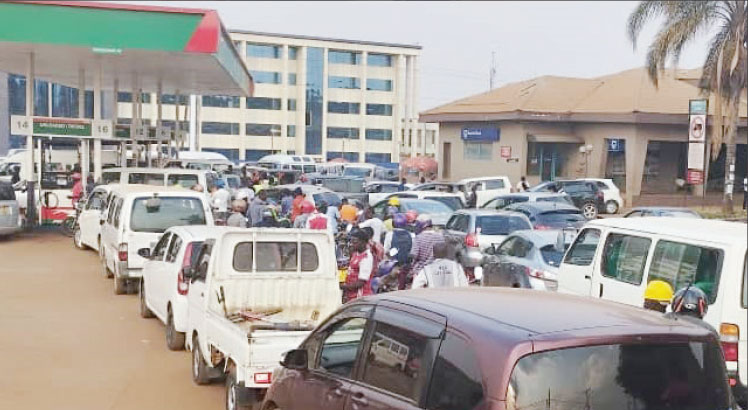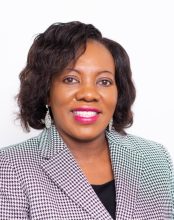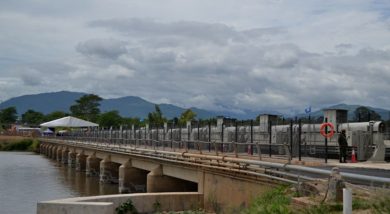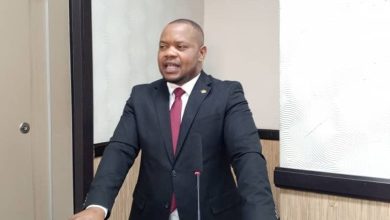Petrol crisis turns ugly
It never rains, but pours for Malawians who continue to endure the never-ending fuel crisis that has prompted public transport operators to increase fares, thereby worsening the economic burden of helpless citizens.
Desperate minibus operators and private motor vehicle owners are this time around being forced to pay up to K5 000 for a litre of petrol, which fetches K1 746 at the pump, to keep going.
The Nation spot-checks in Blantyre, Lilongwe and Zomba, the three cities hard hit by the crisis that is clocking almost a year, established that fares for commuter minibuses have increased.
In an interview in Blantyre, one of the minibus drivers Kuona Botcho said the shortages, attributed to foreign exchange scarcity, was negatively affecting their business.

“Fuel scarcity has affected us as we are not able to make ends meet by the end of the day. For example, I have not conducted business for two days,” he said.
Botcho, who plies between Lirangwe and Limbe, said they resorted to an upward adjustment of fares to cover the cost of fuel on the parallel market.
He said: “Transport fares cannot be the same because we fetch fuel from the black market at a minimum of K4 000 per litre. From Limbe to Lirangwe, the fare is now K2 000 from K1 500 while from Limbe to Chirimba it is K1 000 from K700.”
Charles Kabowa, who operates a motorcycle taxi, expressed the same sentiments when interviewed at the bus stop near Queen Elizabeth Central Hospital in Blantyre.
He said: “At a black market, a litre of petrol costs K5 000 which does not tally with the normal charges. As a result, we have adjusted our charges too. For example, from Ginnery Corner to Ndirande or Nancholi, we are charging K2 000 either way.”
On the other hand, Evans Munthali, a commuter and student at the Malawi University of Business and Applied Sciences (Mubas), lamented that the high fares have affected his budget.
He said: “Before this [week’s] fuel scarcity, I was using K1 400 per day from Maone Park to Mubas via Limbe, but now I am spending K3 200 which is twice the previous amount.”
Sitembi Msiska, who works at Kamuzu University of Health Sciences, said what was worrying was that there was no hope of stabilisation in fuel supply.
She said: “I have been in the queue for over four hours since around 8am. That means I have not been productive all that time and I don’t even know whether I will go back to the office as I am yet to refuel my car.”
In Lilongwe, service stations were equally dry and long queues of vehicles hoping for supply were the order of the day.
In the afternoon, there was commotion at one service station as motorists scrambled for fuel, blocking the M1 and other feeder roads in the process. However, police moved in to restore order.
Like in Blantyre, public transport operators have increased fares with passengers on the Area 25 and 49 route paying between K1 200 and K1 300 from the K1 000 one-way trip to town. The increase in fares was also confirmed in Areas 23 and 36 as well as Kaphiri.
The old capital, Zomba, has been facing prolonged petrol drought and yesterday service stations remained dry while some motorists just abandoned their cars at the stations pending fuel delivery.
On Sunday, there was fuel at Petroda Service Station, but the commodity ran out within hours.
In an interview yesterday, Brian Gama, who operates a taxi between Chinamwali and Zomba Town, said he has not done any business for three days now.
“We are tired of running from filling station to station in search of the commodity. We don’t know when fuel tankers will arrive here,” he said.
Another motorist, who opted for anonymity because she is a civil servant, said she left her car at a filling station on Saturday.
“I used a public transport yesterday from Matawale to work in town and paid K800 on a trip that costs K600,” she said.
Random interviews with passengers in Zomba established that operators plying the Blantyre-Zomba route were demanding K6 000 on a one-way trip that normally costs K3 000.
At around 5pm, some workers and traders in Zomba were seen walking home because most minibuses were not operating as they were grounded at filling stations. On the other hand, those operating were charging double the fare, a tall order for many a Malawian already reeling under a harsh economic environment with inflation hovering around 28 percent.
In Mzuzu, at least two service stations had petrol. This caused a scramble as desperate motorists sought to get the scarce commodity.
In the past two years Malawi has been reeling under an acute foreign exchange shortage due to supply and demand imbalances on the domestic foreign exchange market, declining official foreign exchange reserves and widening spread of rates on the market.
The country requires $3 billion per year to meet import requirements, but only produces $1 billion, according to Reserve Bank of Malawi (RBM) data.
Malawi Energy Regulatory Authority (Mera), National Oil Company of Malawi (Nocma) and privately-owned Petroleum Importers Limited (PIL) have previously attributed the now perennial shortages of fuel in the country to shortage of foreign exchange.
Monthly consumption of fuel is estimated at 51 million litres, but the country is importing around 40.8 million litres due to inadequate foreign exchange.
RBM director of public relations Mark Lungu is on record as having said the central bank was trying its best to ensure that Nocma and PIL are assisted through commercial banks. n
Additional reporting by NATHAN MWAFULIRA, HOLYCE KHOLOWA and JOSEPH MWALE, Staff Writers





